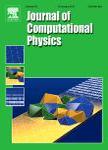版权所有:内蒙古大学图书馆 技术提供:维普资讯• 智图
内蒙古自治区呼和浩特市赛罕区大学西街235号 邮编: 010021

作者机构:Cornell Univ Sibley Sch Mech & Aerosp Engn Mat Proc Design & Control Lab Ithaca NY 14853 USA
出 版 物:《JOURNAL OF COMPUTATIONAL PHYSICS》 (计算物理学杂志)
年 卷 期:2008年第227卷第13期
页 面:6612-6637页
核心收录:
学科分类:07[理学] 0812[工学-计算机科学与技术(可授工学、理学学位)] 0702[理学-物理学]
基 金:Direct For Mathematical & Physical Scien Division Of Mathematical Sciences Funding Source: National Science Foundation
主 题:stochastic partial differential equations data-driven models non-linear embedding manifold learning model reduction collocation methods sparse grids microstructure
摘 要:Stochastic analysis of random heterogeneous media (polycrystalline materials, porous media, functionally graded materials) provides information of significance only if realistic input models of the topology and property variations are used. This paper proposes a framework to construct such input stochastic models for the topology and thermal diffusivity variations in heterogeneous media using a data-driven strategy. Given a set of microstructure realizations (input samples) generated from given statistical information about the medium topology, the framework constructs a reduced-order stochastic representation of the thermal diffusivity. This problem of constructing a low-dimensional stochastic representation of property variations is analogous to the problem of manifold learning and parametric fitting of hyper-surfaces encountered in image processing and psychology. Denote by M the set of microstructures that satisfy the given experimental statistics. A non-linear dimension reduction strategy is utilized to map M to a low-dimensional region, A. We first show that M is a compact manifold embedded in a high-dimensional input space R-n. An isometric mapping F from M to a low-dimensional, compact, connected set ACR(d) (d A. Asymptotic convergence of the representation of M by A is shown. This mapping F serves as an accurate, low-dimensional, data-driven representation of the property variations. The reduced-order model of the material topology and thermal diffusivity variations is subsequently used as an input in the solution of stochastic partial differential equations that describe the evolution of dependant variables. A sparse grid collocation strategy (Smolyak algorithm) is utilized to solve these stochastic equations efficiently. We showcase the methodology by constructin